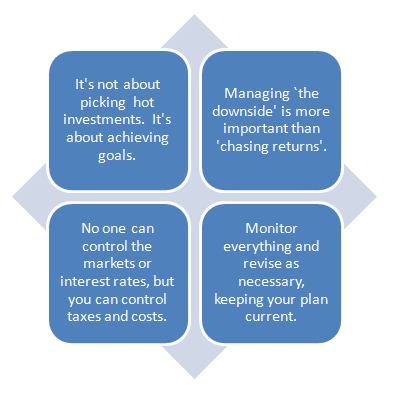
Jim Lorenzen, CFP®, AIF®
It’s probably a safe assumption that most individual investors began their investment programs with mutual funds and have built their 401(k)s, IRAs, and/or taxable accounts with mutual funds ever since.
While those mutual funds may have been appropriate for them in those early days, are they appropriate today?
If you’re one of those who’s built your retirement portfolio with mutual funds over the years and now have more than $500,000 invested in your long-term nest-egg, you may want to consider how much you may be losing to factors that have little to do with “the market”. It begins with the Four Pillars of Investment Success.
For this post, we’ll talk about the bottom-left pillar, particularly as it relates to cost.
By now, most people are aware of the difference between ‘load’ and ‘no-load’ mutual funds. Loads are basically sales charges that pay compensation to the selling registered representative of a broker -dealer. They’re not necessarily bad. A small investor can seldom be economically serviced by a fee-based registered investment advisor and this economic model provides that investor access to help that otherwise may not be available. Either way, those charges aren’t hidden; they’re disclosed. Here are some additional charges worth discussing:
Annual expense ratio
This is also disclosed in a mutual fund’s prospectus. For example, assume a growth mutual fund has an expense ratio of 1.40%. You’ll find it disclosed; but here’s what that 1.4% doesn’t include:
Turnover.Turnover is an important factor in determining a fund’s true costs. You see, turnover impacts other costs, as you’ll soon see.
Transaction/trading costs:When a fund manager makes a trade on an exchange, that trade incurs a commission – just like your own trade would – and the fund manager receives a `confirm’ reflecting the net proceeds of the trade AFTER commissions have been taken… the same kind of ‘confirm’ you would receive. They report the NET proceeds after the cost of the trade.
Look on your most recent mutual fund statement – any fund. Do you see trading costs or any other fees or expenses disclosed on the statement… anywhere? You might think it’s all in the annual expense ratio; but think again. Transaction costs are NOT included in the fund’s annual expense ratio!
In the book, Bogle on Mutual Funds, the former Vanguard Fund chairman estimated trading costs generally average 0.6% I don’t know the real number, so for illustration, I’ll use his. If hypothetically a fund’s turnover is 120% – check the prospectus for your fund’s turnover – here’s what it means in calculating expenses:Trading Costs (use a low-end figure) x Turnover = Total trading costs. So, 0.6% x 2.2 = 1.32%.
Why use the 2.2 factor for a 120% turnover? Simple: You have to establish a position in a security before you can turn it over; and, that’s true for each security in the portfolio. The entire portfolio is established, then 120% is `turned over’ in a year. If you used 1.2, you’d be computing only a 20% turnover, far from what’s really happening. So, trading cost times turnover gives us 1.32% in trading costs, to add to the fund’s annual expense ratio to get combined annual expenses plus trading costs.
According to Morningstar, the typical equity fund has annual expenses of 1.4% annually. If we use that figure for illustration – remember to look at your own funds’ prospectuses to see what applies to you – 1.32% + 1.40% = 2.72% in annual costs.
Market impact costs: When you or I sell 100 shares of a security, it doesn’t really impact the price. But, when an institution buys or sells huge blocks of a security, the price can be affected. How much? Market impact costs can range between 0.15-0.25%. And, of course, you would apply that figure to turnover, too. We’ll use the lower number for our hypothetical illustration.0.15% x 2.2 = 0.33%. So our hypothetical fund with a 1.4% annual expense ratio that experiences a 120% annual turnover could actually be costing the shareholder 3.03% annually.
Annual Expense Ratio 1.40%
Turnover 2.2 x 0.6% 1.32%
Market Impact Costs 2.2 x 0.15% 0.33%
Total 3.05%
This means, according to this calculation of our fictitious fund – the one we assumed had an annual expense ratio of 1.40% – the total real annual expenses to the shareholder are actually 3.05%, more than twice the annual expense ratio reflected in the prospectus; and those additional costs are nowhere to be found on the statement.
Okay, you now know what to look for. Pull out your statements and prospectuses and do your own math. You may have to make a guess for market impact and trading costs, or you can use Mr. Bogle’s – you probably won’t be far off.
Here’s another point worth remembering. Using our hypothetical fund example, if you’re paying 3% all-in for a $100,000 investment, you’re paying about $3,000 per year; but, the percentages don’t drop as your assets increase! If you have a $1 million dollar portfolio, you’re now paying $30,000 per year – and, that’s just for the fund!
As I said at the outset, if your portfolio is over $500,000, there’s probably a better way to get responsible management, a good investment allocation, and even professional guidance – all for less than you may be paying simply to be in mutual funds now.
You may want to check into it. Naturally, I’d be happy to help.
Jim
If you have $500,000 or more and are looking for an independent fiduciary advisor, you can get started here.

Jim Lorenzen is a CERTIFIED FINANCIAL PLANNER® professional and an ACCREDITED INVESTMENT FIDUCIARY® serving private clients since 1991. Jim is Founding Principal of The Independent Financial Group, a registered investment advisor with clients located across the U.S.. He is also licensed for insurance as an independent agent under California license 0C00742. The Independent Financial Group does not provide legal or tax advice and nothing contained herein should be construed as securities or investment advice, nor an opinion regarding the appropriateness of any investment to the individual reader. The general information provided should not be acted upon without obtaining specific legal, tax, and investment advice from an appropriate licensed professional.






